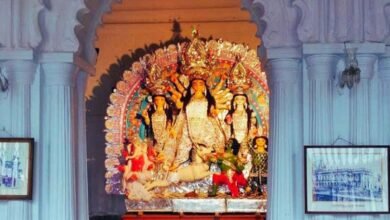The story of Matangini Hazra, fondly known as ‘Gandhi Buri’

On this day in 1942, Matangini Hazra who is known as old lady Gandhi due to her non-violent protest inspired by the Father of the Nation, died of police bullets holding the flag high, unsoiled
West Bengal, India – 29 Sept 2019: Matangini Hazra was born in a poor household in the Tamluk district, who died today in 1942. Fondly remembered as ‘Gandhi Buri’ or old lady of Gandhi, Hazra was shot dead by the British police as she stepped forward to appeal against open firing by the policemen.
Born to a poor household, she was married early to a 60-year-old widower Trilochon Hazra, only to be a widow at 18. Her affair with the freedom fight began at 35 years of age when she joined the independence movement and became a Gandhi follower.
Matangini’s humble beginnings
Born as Matangini Maity in 1870 in Penury in Hogla village located under the jurisdiction of Tamluk Police station in Medinapore, she could not even pursue early education. The abject poverty compelled her to become a child bride and a mother of a young son. She returned to her village when she was 18 years old, widowed, and childless.
Hazra then began building her separate establishment in her paternal village and spent most of her time helping old and diseased around her house. At that point, little did she know that how her future would pen her as an unsung women hero of freedom struggle.
Hazra’s political debut
Matangini’s active interest in the freedom struggle spiralled in 1905, drawing inspiration from none other than Gandhi. As per the documents, the freedom struggle in Medinapore was characterized by the huge women participation.
However, the turning point in her life came on January 26, 1932, known as Indian Independence Day in those days. The village men marched into an awareness procession about the then political scenario, and Hazra joined the group at 62. Since then, there was no looking back for her.
Why people called her Gandhi Buri
There is no doubt that Matangini Hazra was an ardent Gandhi follower. She joined the freedom struggle after being inspired by Mahatma himself. Like him, she declined all foreign goods and spun her yarn. People often recalled her for the humanitarian work in the village.
Her vigorous participation in Mahatma Gandhi’s Civil Disobedience Movement made her infamous in the police barracks, especially her role in the Salt Satyagraha movement. She made salt in the Alinan salt-making factory. Alinan is her late’s husband village. It led to her arrest, and people watched a fragile old woman walking several miles without a single frown on her face. She was promptly released.
Gandhi Buri in Bengali translates to the old lady Gandhi. The local people used to call her old lady Gandhi due to her dedication to following the Gandhian principles of freedom struggle. Her arrest could not deter her from contributing to the freedom struggle.
Strong and gritty like Gandhi
Like Mahatma Gandhi, Hazra’s fragile body could not deter her from participating in the freedom struggle. She was also a local voice against the British atrocities. Soon after her arrest, Matangini Hazra participated in the abolition of the Chowkidari tax- a tax enforced on villagers by the British to fund a small local group of policemen to be used as spies against the villagers.
Following her release, Hazra started to spin Khadi as a sign of protest despite failing eyesight. During the outbreak of the smallpox epidemic, she had tirelessly nursed the victims, including the children.
Matangini was also grievously injured in the police baton charge in 1933 while attending the sub-divisional conference of the Indian National Congress. She received severe blows and was hurt in the process.
Her protest style was similar to Gandhi and his motto of non-violence freedom struggle to attain real freedom. Later in 1933, during the visit of the then Governor of Bengal Sir John Anderson, she managed to breach the security and reach the dais to raise the black flag as a symbol of protest. The British government rewarded her with six months imprisonment.
Matangini Hazra’s Supreme Sacrifice
In 1942 August, the local Congress workers planned to protest near various police stations and government offices in the Medinapore district under the leadership of 73-year-old Matangini Hazra.
On September 29, she led around six thousand protesters, mostly women, to besiege the Tamluk police station. The police tried to stop the procession, citing Sec. 144 of IPC. But the defiant Hazra stepped forward, appealing to the policemen not to open fire. In return, she was shot at arm but kept moving forward with the flag held high.
The next bullet was fired, and it hit her in the forehead taking her life. Later her body was found lying in the pool of blood, holding the flag high, unsoiled.







